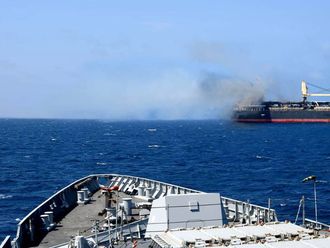Sana’a: The Al Houthi rebels in northern Yemen have never been given as much attention as in recent times as they continue to organise massive protests in the Yemeni capital to demand the departure of the government and the reviewing of fuel subsidies. For nearly a decade, the Al Houthi group has been battling opponents away from the capital. Yemen president Abd Rabbo Mansour Hadi strongly criticised the group for the first time, saying they use the controversial fuel subsidies as a “mask” for other agendas, which include occupying the capital.
Who are they?
The Al Houthis were named after their late leader Hussain Badr Al Deen Al Houthi who was killed by army forces in 2004. According to the group’s official website, Hussain Al Houthi came back from Sudan in the early 90s after finishing his MA in Quranic science (some reports said he quit), and devoted all his time to reading the Quran.
The Al Houthis say that after deep contemplation into the texts of the Quran, their leader came out with a conclusion; the USA and Jewish people were behind all the troubles of the Islamic nations.
To enlighten people about the alleged conspiracies against Muslims, the young leader created the popular slogan (Sarkha), “God is Great! Death to America! Death to Israel! Curse the Jews! Victory to Islam!” and urged followers to chant it wherever they are.
In 2004, steadfast supporters spilled into the mosques of the northern Saada province, while others cursed the US and Jewish people in the Yemeni capital.
Annoyed by their chants, the former president Ali Abdulla Saleh arrested followers in the old Sana’a city and sent troop to capture the Al Houthi leader in Saada.
Wars
The first armed confrontation between Saleh’s troops and the Al Houthis erupted in 2004 when troops failed to capture Hussain Al Houthi. The Al Houthis said on their website that Saleh was trying please the Americans.
Saleh said in an interview with Al Arabiya TV in 2013 that he ordered troops to protect local people from the Al Houthis who were imposing a tax on them. The sporadic conformations continued until 2010 when both sides agree to ceasefire.
Despite showing public enmity to the US and Israel, the Al Houthis have never been involved in any plot on the US or western interests in Yemen.
As the peace prevailed in the war-torn province of Saada, the rebels were in control of the districts except a small region called Dammaj that hosted the conservative Salafis.
Also known as Ansarallah, the Al Houthis complained about decades of social, economical and religious marginalisation by former regimes in the north.
Uprising
In 2011, the Al Houthis were in the leading lines of mass protests calling for the removal of Saleh’s regime. The rebels echoed the same demands of the protesters; Saleh’s prosecution, fighting corruption and building a civilian state.
Saleh agreed to step down in 2012 and passed power to his deputy Abd Rabbo Mansour Hadi. But shortly after the inauguration of the new president, the Al Houthis engaged in their first sectarian clashes with their rival Sunni groups. The rebels besieged thousands of Salafists for months, allegedly to prevent the flow of foreign fighters to the area.
Some tribal forces, such as the powerful Hashed tribe, joined the conflict. The conflict ended when the Salafists agreed to be relocated in the capital earlier this year.
“They exploited the transitional period and weakness of the state to control new territories in Saada, Amran, Jawf and Sana’a,” Abdul Salam Mohammad, the director of Abaad Centre, told Gulf News.
“They have some legitimate demands like equal citizenship, fair distribution of wealth and improving people’s basic amenities like bread, health and education.
The Al Houthis were also among many political forces that agreed to join the transitional talks, known as the National Dialogue Conference, and were represented by 35 delegates. Their representatives walked out of talks in the last days of the conference in protest against a proposal to divide the country into six regions. The rebels were placed in a poor region that has no access to the sea.
Settling scores with the tribesmen who supported the Salafists in Dammaj, the Al Houthis battled Hashed tribesmen in some districts in Amran province on July. The rebels defeated the tribesmen and bombed the house of their leader Hussain Ahmer.
Political and military wings
Analysts say that the rebels have two wings; political and military. The first is stationed in the capital while the other is in Saada planning the group’s battles in the north.
“There are a handful of intellectual elites representing the Al Houthis in the capital who work on improving the image of the group,” Abdul Fattah Haidrah, a political analyst based in Dubai, told Gulf News. “But the armed wing is organised and more powerful and calls the shot,”
In 2013, the group moved quickly to another districts in Amran, Jawf, Hajja and Mareb. On July 7, the Al Houthi expansion reached the capital when they got control of the province of Amran, the stronghold of the Hashed tribe and killed a prominent army general.
The rebels describe their armed confrontations in these provinces as a “revolution” by local destitute people against the family of Al Ahmer and the Islah party.
“The group has a dream of bringing back the ruling of the Hashemite families in Yemen who were removed from power [in the] 60s in the wake of [the] September 26 Revolution.” Mohammad said.
The rebel’s quick expansion in the north has left many observers pondering over their ability to win the hearts and minds of local tribes.
Haidrah attributed the quick rise of the group to many social and political reasons. These include exploiting local people’s grievance and government’s corruption.
Haidrah said: “The Al Houthis also cashed in on local people’s resentment against the sons of Abdulla Al Ahmer who were part of the former and current regimes and exploited positions to achieve their interests,”
Despite their assurances that they are confronting injustice and marginalisation, Haidrah maintains that the group has a dark side.
“Human rights organisations have reported serious violations against individuals and institutions in their strongholds. They are dyed-in-the-wool traditionalists who do not believe in art or modern science and think they have the right to rule because of their lineage [to the Prophet Mohammad, PBUH].”












